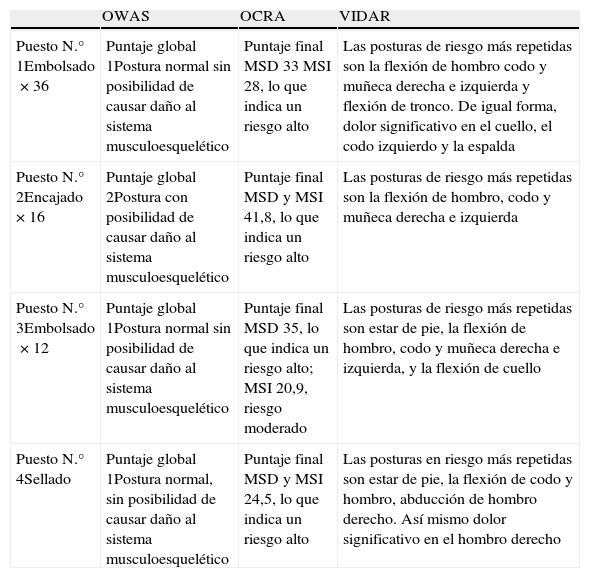Comparar 4 metodologías de evaluación de los desórdenes musculoesqueléticos con el fin de determinar cómo se debe llevar a cabo el proceso de evaluación de puesto de trabajo.
Material y métodoEstudio comparativo de 4 puestos de trabajo en el proceso de empaque, a partir de un análisis de puesto de trabajo con las metodologías Ovako Working Posture Analysing System (OWAS), índice checklist Occupational Repetitive Action (OCRA) y VIDAR.
ResultadosEl puesto número 1 obtuvo un puntaje de 1 en OWAS, indicando postura normal; en OCRA arroja un riesgo alto, y en VIDAR muestra 4 posturas de riesgo. El puesto número 2 obtiene un puntaje de 2 en OWAS, indicando una postura con posibilidad de causar daño; en OCRA un riesgo alto, y en VIDAR alerta de 3 posturas de riesgo. El puesto número 3 obtiene en OWAS un puntaje de 1, en OCRA un riesgo alto y en VIDAR alerta de 5 posturas de riesgo. El puesto número 4, en OWAS obtuvo 1, en OCRA riesgo alto y en VIDAR indica 4 posturas de riesgo.
DiscusiónLas metodologías OWAS y OCRA logran cuantificar el riesgo al que está expuesto el trabajador, mientras que VIDAR presenta resultados cualitativos pero tiene en cuenta la percepción del trabajador.
Desarrollos futurosEn la evaluación de puestos de trabajo se requiere un análisis que identifique los riesgos; posteriormente, se deben aplicar metodologías para delimitar los riesgos y por último aplicar VIDAR para vincular la fuente de riesgo con la percepción del trabajador.
To compare four methods of evaluating musculoskeletal disorders in order to determine how to carry out the job evaluation process.
Material and methodA comparative study of four works stations in the packing process based on an analysis with the methodologies Ovako Working Posture Analyzing System (OWAS), Occupational Repetitive Action (OCRA) check list index and VIDAR was performed.
ResultsWork station No. 1 obtained a score on OWAS 1 indicating normal posture, OCRA indicated high risk and VIDAR showed four risk positions. Station No. 2 had a score of 2 on OWAS indicating a position with the possibility of causing damage, high risk in OCRA and VIDAR showed an alert for three risk positions. Station No. 3 obtained a score of 1 on OWAS, high risk in the OCRA and VIDAR alerted to five positions of risk. Station No. 4 had a score of 1 for the OWAS, OCRA showed high risk and VIDAR indicated four positions of risk.
DiscussionThe OWAS and OCRA methodologies are able to quantify the risk that a worker has, VIDAR presents qualitative results, but it takes the worker perception in account.
Future developmentsIt is necessary to use an analysis that identifies risks in the evaluation of work stations. After, methodologies should be used to define the risk and then the VIDAR should be applied to link the source of risk with the perception of the worker.
Artículo
Si ya tiene sus datos de acceso, clique aquí.
Si olvidó su clave de acceso puede recuperarla clicando aquí y seleccionando la opción "He olvidado mi contraseña".Comprando el artículo el PDF del mismo podrá ser descargado
Precio 19,34 €
Comprar ahora











